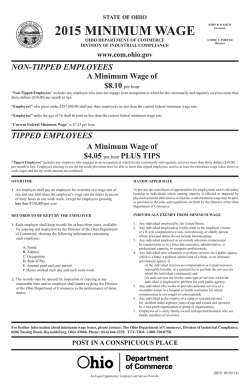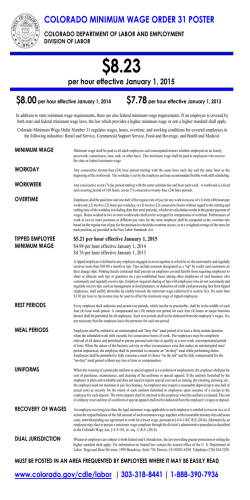
The Impact of Income Inequality with Distortionary Taxes on
The Impact of Income Inequality with Distortionary Taxes on Economic Growth
Randy Cragun
Econ 915
There has been much disagreement about the role of income inequality in determining
economic growth rates. Alesina and Rodrik (1994) and Persson and Tabellini (1994) suggest
that greater income inequality (in the sense of median income or wealth holdings falling further
below the mean) decreases economic growth by increasing redistribution, even when taxes are
used for productive expenditures. They both give empirical evidence from cross sections of
countries. Their theory is consistent with Meltzer and Richard (1981), who show an increasing
role for government when the voting franchise is extended to more poor people. Saint-Paul
and Verdier (1993) showed that redistribution could be growth-enhancing when it is used for
public education. Banerjee and Duflo (2003), however, show a non-monotonic relationship
between inequality and growth in country panels.
The purpose of this paper is to evaluate the role of wage inequality in determining
economic growth rates in the presence of distortionary income taxes when redistribution is not
productive. We will show that while consumption growth is decreasing in the tax rate, for a
given tax rate the impact of inequality on consumption growth will depend on the form of the
change in the distribution of productivity. If there are two masses of workers with different
productivities, changing the masses will affect growth differently than changing the locations
(productivities) of those masses. We will find that this trend persists when we look at the
different policy choices of democracies with different wage distributions: a higher wage
differential is growth-reducing while a higher poor proportion of the population (beyond a
particular level) is growth-enhancing. We posit that income shares captured by low- and highskilled workers, rather than inequality itself, are the important factors for determining policy
and growth.
We will first define the variables used in the paper and then look at taxes on interest
income. We will then lift the interest income taxes and focus instead on the effects of standard
income taxes on the labor-leisure choice and attending effects on consumption growth. Finally,
we will turn to a brief treatment of the relevant political economy.
Variable definitions
[
]
is the proportion of people that are low-skilled (have a low
).
is the initial ratio of low-skilled to high skilled productivity
denotes low-skilled workers, and
denotes high-skilled workers.
is the productivity of a person of type at time .
[
]
is the education investment effort of type at time .
[
]
is the labor effort of type at time .
is the consumption of type at time .
is the production income of type at time .
is saving by type at time .
is the assets type holds at time from the previous period.
[
]
is the constant income tax rate.
is a uniform rebate at time .
is the rate of interest set on international financial markets.
Type subscripts are suppressed where it is convenient to do so. Greek letters represent
parameters of production or utility functions and are never choice or policy variables.
Taxes on interest earnings
It is easy to show that taxes on interest income will reduce consumption growth.
Consider a small, open economy that takes the interest rate as given. Each agent in the
(
economy has homothetic preferences ordered by
).
Production income for an
individual in period is given by
This income net of taxes can be used for consumption or saving. Saving adds to assets, and
assets earn interest income (which is taxed again) in the next period.
Thus consumption in period is
(
)
(
)
and assets in period are
Finally, allow human capital to be acquired through time spent not working. This time is
not taxed.
(
)
This will permit easier comparisons to subsequent models in this paper.
Then if there are only two periods of life, the problem for each person is to maximize
(
) subject to
[
(
) ]
[
(
) ](
)
(
)
(
)
[
(
) ]
We can see in this constraint the obvious fact that the interest income tax changes the
effective rate of interest on saving. Each agent chooses
and
so the marginal rate of
substitution satisfies
[
(
) ]
As the tax on interest increases, the marginal rate of substitution must fall. If
homothetic,
⁄
is
must also fall. Note that productivity inequality here is irrelevant, because
each person chooses the same consumption growth. This rate is determined by the tax rate
(the same value for all agents) rather than the actual level of taxes paid by each person (which
differs between people with different productivities).
Labor-leisure distortions
In the previous section, we showed that interest income taxes lower the consumption
growth rate. However, income taxes that do not apply to interest earnings (the case where
) also distort consumption growth. Consider a more general model, where the choice of
labor supply does more than just determine human capital accumulation: time spent not
working and not in school is a good.
Each agent has preferences ordered by
(
)
(
)
and faces constraints
(
{
)
(
)(
)
The first order conditions with respect to
(
and
)
(
give us that
)
Then the first order conditions with respect to
and
[ (
give us that
)]
Thus education investment is chosen solely based on conditions in the financial market and
individual time preferences. This does not make it irrelevant, since it takes time away from first
period labor and leisure.
Then the first order conditions with respect to
(
)
and
give us that
(
Then the first order conditions with respect to
(
)
)
and
give us that
(
)
Substituting into the constraint shows that
(
)
(
)
(
)(
)
To simplify notation, we will let
(
assuming that
)
is large.
Heterogeneity
We have determined the behavior of individuals in response to any given tax and rebate
policy. But the purpose of this paper is to evaluate the interactions of wage inequality and
income taxes. Thus we will introduce a government budget constraint and will also introduce
heterogeneity among individuals.
There are two different kinds of people: low-skilled and high-skilled, with initial
productivities
and
, respectively.
is the proportion of people that are low-skilled.
The government balances its budget in each period:
(
(
{
The equilibrium value for
(
(
)
)
)
)
is
̅
where ̅
(
)
is the initial average productivity.
is endogenous, but we
previously solved for its value.
(
)
)̅
(
if this induces labor supply for both types in [
]. Because a model that predicts that no one
will work or that some people will work perpetually is not a very good representation of the
[
world, we will consider cases only where
induces
, then
) and
(
). If the above solution
, and
(
)
(
̅
)
(
)(
(
(
)
)
For the internal solution,
(
(
)
)
(
̅
)
)
̅
But once the tax rate is high enough that low-skilled people stop working, high-skilled workers’
tax rebates stop falling from reductions in low-skilled labor supply, and these higher rebates
reduce high-skilled labor faster (as the tax rate increases) than if low-skilled labor could also
respond to tax increases. In this case,
(
(
)
)(
(
)
)
(
(
)(
)
)
̅
In both cases the first period labor supply is a decreasing function of the tax rate.
Consumption growth for each person will be
where
is determined as above.
The consumption growth rate is decreasing in the tax rate:
Thus when
(at high tax rates),
, because (looking back at the first order
conditions) the growth rate of consumption depends only on the rate of education investment
and the intertemporal ratio of leisure, which are both independent of
when
is sufficiently
high to induce no work effort.
Figure 1 shows typical graphs of low-skilled, high-skilled, and aggregate consumption
growth for levels of the tax rate. Low-skilled consumption growth levels off above a particular
tax rate. As shown above, this is at the exact point when low-skilled first period labor supply
hits zero.
We see that consumption growth falls as the tax rate rises, but the question for us is
how this effect responds to changes in the productivity distribution. We will use two measures
of changes in inequality. First, we will consider the effects of differences in the proportion of
the population that is low-skilled, holding relative productivity constant, and then we will
consider differences in the relative productivity of the high- and low-skilled workers. In fact, in
the model presented here, the average level of productivity does not affect the rate of
consumption growth, since the rate of education investment is independent of the wage
distribution, and the level of labor supply depends only on the ratio of own productivity to
average productivity.
Figure 1: Consumption growth ( = .75, = .2)
8
Low-skill
High-skill
Aggregate
7
Consumption Growth
6
5
4
3
2
1
0
0
0.1
0.2
0.3
0.4
0.5
0.6
Tax Rate
0.7
0.8
0.9
1
Figure 2 displays consumption growth for low-skilled workers for populations with
various proportions that are low-skilled. What we see is that when there are more unskilled
workers, they choose higher consumption growth. Figure 3 displays consumption growth for
high-skilled workers for populations with various proportions that are low-skilled, and we see
similarly that when there are more unskilled workers, the skilled workers choose higher
consumption growth. Thus every individual who does not magically change classes when the
distribution of productivity changes will increase his or her consumption growth if there are
more poor in the economy. However, this result is misleading; it does not suggest that
aggregate growth is higher in economies with less wage equality. If there are more low-skilled
workers, aggregate growth will be weighted more toward the (usually) lower consumption
growth of the low-skilled workers, so aggregate growth could actually fall as the wage
distribution shifts toward more low-skilled workers.
Figure 2: Consumption growth for low-skilled workers ( = .2)
Figure 3: Consumption growth for high-skilled workers ( = .2)
8
9
= .6
= .75
= .9
7
7
Consumption Growth
Consumption Growth
6
5
4
3
2
6
5
4
3
2
1
0
= .6
= .75
= .9
8
1
0
0.1
0.2
0.3
0.4
0.5
0.6
Tax Rate
0.7
0.8
0.9
1
0
0
0.1
0.2
0.3
0.4
0.5
0.6
Tax Rate
0.7
0.8
Figure 4 shows growth of aggregate consumption for populations with various
proportions that are low-skilled. Both the size and magnitude of the change in consumption
growth depend on the tax rate. At low tax rates, the increase in individual consumption growth
0.9
1
exactly offsets the effect of a bigger weight on low-skilled growth. At tax rates sufficiently high
to induce zero labor supply among low-skilled workers, consumption growth rates among lowskilled workers are higher than they would be if labor supply could continue to fall below zero.
Consider figure 2 again. If the proportion of low-skilled workers fell from .75 to .6, the growth
rate that would offset the loss of high skilled workers to give us the same aggregate growth
rates in the two scenarios (imagine that the green line extends downward rather than leveling
off) is less than the observed low-skilled consumption growth rate.
Thus the aggregate
consumption growth rate will be higher with fewer low-wage workers. At higher tax rates, the
loss of high-wage workers dominates the positive impact of higher low-wage consumption
growth.
Figure 4: Aggregate consumption growth ( = .2)
4
= .6
= .75
= .9
3.5
Consumption Growth
3
2.5
2
1.5
1
0.5
0
0.3
0.4
0.5
0.6
0.7
Tax Rate
0.8
0.9
1
We see similar patterns from differences in relative wages (Figures 5 through 7).
However, inequality in relative wages affects the growth rates among the poor in an opposite
manner from the effect of increasing the proportion of the population that is poor.
Furthermore, at any given tax rate we never observe higher aggregate consumption growth at
higher relative productivity for unskilled workers.
Figure 5: Consumption growth for low-skilled workers ( = .75)
Figure 6: Consumption growth for high-skilled workers ( = .75)
8
9
= .2
= .3
= .5
7
7
Consumption Growth
5
4
3
2
6
5
4
3
2
1
1
0
0.1
0.2
0.3
0.4
0.5
0.6
Tax Rate
0.7
0.8
0.9
1
0
0
0.1
0.2
0.3
0.4
Figure 7: Aggregate consumption growth ( = .75)
4
= .2
= .3
= .5
3.5
3
Consumption Growth
Consumption Growth
6
0
= .2
= .3
= .5
8
2.5
2
1.5
1
0.5
0
0.3
0.4
0.5
0.6
0.7
Tax Rate
0.8
0.9
1
0.5
0.6
Tax Rate
0.7
0.8
0.9
1
Political Economy
There is still more to the story. Economies with different wage distributions will
probably have different tax policies. We should think of tax policies and income distribution as
simultaneously determined, but we follow the focus of past researchers who emphasized the
role of inequality in determining policy. This paper considers only democracies with universal
suffrage.
Optimally, we would want to show that preferences over tax policy are single-peaked or
possess the single-crossing property, but we will assume that the voter with median
productivity is decisive, and we will assume as we have throughout this paper that over half the
population is poor. We can choose the tax and rebate policy that maximizes the welfare of the
low-skilled workers and observe how growth rates change as inequality changes.
The median voter would like to redistribute all income, but a tax rate of 1 would induce
zero production. For each wage distribution, the decisive voter chooses a point from a Laffer
curve like those in Figures 8 and 9. The downward sloping portion of the curve is never optimal,
since the same rebate could be attained at lower cost. Each potential policy choice from Figure
8 can be evaluated against the others with the indirect utility functions in Figures 10 and 11.
The decisive voter chooses the tax rate corresponding to the highest point on each curve. This
preferred tax rates as functions of the proportion of the population that is low-skilled and of
the productivity ratio is graphed in Figures 12 and 13. In Figure 12, we see that when there are
few poor people, increases in their number (decreases in the number of rich) are offset by
higher taxes, but when there are more poor people, the increment in tax revenues from a rate
hike is too small to justify the cost.
Figure 8: Feasible tax policies ( = .2)
Figure 9: Feasible tax policies ( = .75)
2.5
1.8
= .6
= .75
= .9
1.4
Present Value of Tax Rebates
Present Value of Tax Rebate
2
= .2
= .3
= .5
1.6
1.5
1
0.5
1.2
1
0.8
0.6
0.4
0.2
0
0
-0.5
0
0.1
0.2
0.3
0.4
0.5
0.6
Tax Rate
0.7
0.8
0.9
-0.2
1
0
= .6
= .75
= .9
0.4
0.5
0.6
Tax Rate
0.7
0.8
0.9
1
= .2
= .3
= .5
1.4
1.4
1.2
1.2
Indirect Utility
Indirect Utility
0.3
1.6
1.6
1
0.8
1
0.8
0.6
0.6
0.4
0.4
0
0.1
0.2
0.3
0.4
0.5
0.6
Tax Rate
0.7
0.8
0.9
0.2
1
0
Figure 12: Tax policy chosen for given wage ratios ( = .2)
0.2
0.3
0.4
0.5
0.6
Tax Rate
0.7
0.8
0.9
1
1.6
Tax rate
Rebate
Tax Rate and Present Value of Tax Rebate
1.4
1.2
1
0.8
0.6
0.4
0.2
0.6
0.1
Figure 13: Tax policy chosen for given wage ratios ( = .75)
1.6
Tax Rate and Present Value of Tax Rebate
0.2
Figure 11: Indirect utility of tax policies for low-skilled workers ( = .75)
Figure 10: Indirect utility of tax policies for low-skilled workers ( = .2)
1.8
0.2
0.1
0.65
0.7
0.75
0.8
Low-skilled Proportion ()
0.85
0.9
Tax rate
Rebate
1.4
1.2
1
0.8
0.6
0.4
0.2
0.2
0.25
0.3
0.35
0.4
Labor Productivity Ratio ()
0.45
0.5
The tax rates chosen (as in Figure 13) induce particular consumption and income growth
rates, as graphed in Figure 14. Here we have an almost complete picture of the situation. As a
greater proportion of the population is low-skilled, they choose a lower tax rate and higher
consumption and income growth. We can draw the corresponding graphs for changes in the
wage ratio rather than for changes in the proportion that are low skilled. Figure 15 presents
the chosen tax rates and consumption and output growth. As the median productivity falls
relative to the mean productivity, the state plays a bigger role and consumption and output
growth fall. A meaningful way to interpret this information is likely that the income share
captured by the poor without redistribution is the dominant factor determining policy and
growth. As the number of low-skilled workers increases, tax revenues earned from the rich
decline, so redistribution becomes less enticing, and the poor rely more on private returns to
growth activities. Similarly, when the relative wages of low-skilled workers increase, the cost of
taxes to them increases, so they again rely more on private returns to growth activities.
Figure 14: Growth rates for given wage ratios ( = .2)
Figure 15: Growth rates for given wage ratios ( = .75)
16
16
Consumption Growth
Income Growth
12
10
8
6
4
12
10
8
6
4
2
0
0.6
Consumption Growth
Income Growth
14
Consumption and Income Growth
Consumption and Income Growth
14
0.65
0.7
0.75
0.8
Low-skilled Proportion ()
0.85
0.9
2
0.2
0.25
0.3
0.35
0.4
Labor Productivity Ratio ()
0.45
0.5
Conclusions
We have shown that consumption growth is decreasing in the tax rate, but that for a
given tax rate the impact of inequality on consumption growth is ambiguous. However, when
we account for the different policy choices of democracies with different wage distributions, we
find that greater inequality decreases both consumption and income growth.
A limitation of this paper is that it does not allow the tax policy to change in the future.
Although it is not possible in this simple model, inequality could change over time, so that the
preferred policy would change. Then agents would alter behaviors in anticipation of the policy
changes.
One justification of the present specification is that the ordering of agents’
productivities is unlikely to change from deterministic investment in the presence of identical
preferences. While there might be inter-class mobility due to the emergence of vastly different
preferences or wealth (from intelligence or lottery winnings, for instance) in one generation of
a dynasty, such changes are unlikely to alter the overall trend seen here.
Alesina, Alberto, and Dani Rodrik (1994). “Distributive politics and economic growth.” Quarterly
Journal of Economics, 109.
Banerjee, Abhijit, and Esther Duflo (2003). “Inequality and growth: What can the data say?”
Journal of Economic Growth, 8.
Meltzer, Allan, and Scott Richard (1981). “A rational theory of the size of government.” Journal
of Political Economy, 89.
Persson, Torsten, and Guido Tabellini (1994). “Is inequality harmful for growth? Theory and
evidence.” American Economic Review, 84.
Saint-Paul, Gilles, and Thierry Verdier (1993). “Education, democracy, and growth.” Journal of
Development Economics, 42.
© Copyright 2025



![Flyer on the event [PDF]](http://s2.esdocs.com/store/data/000461133_1-4d88ad04a2122eb11dffd05a58c0a0a8-250x500.png)




